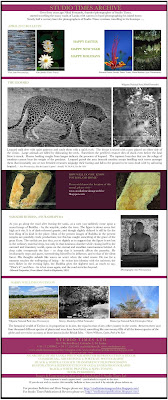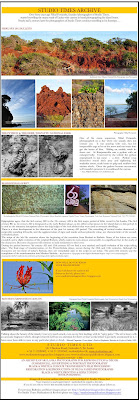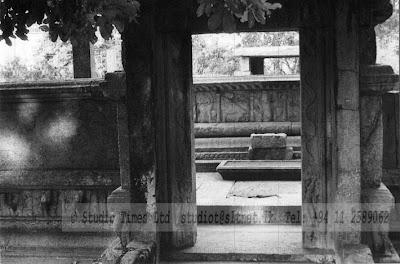Monday, December 3, 2012
Monday, November 5, 2012
Thursday, October 4, 2012
STUDIO TIMES BULLETIN - OCTOBER 2012
Wednesday, September 12, 2012
STUDIO TIMES BULLETIN - SEPT 2012
Gin Pol (Nypa fruiticans)
Monday, August 6, 2012
Monday, July 9, 2012
Wednesday, June 6, 2012
STUDIO TIMES BULLETIN-JUNE 2012
Sunday, May 13, 2012
STUDIO TIMES BULLETIN - MAY 2012
Wednesday, April 4, 2012
STUDIO TIMES BULLETIN - APRIL 2012
 Gonagolla Murals:
Gonagolla Murals:

Gonagolla was once adorned with the most beautiful paintings in Ruhuna. A male and a female figure are all that remain, a maiden with a princely Bodhisattva at her side. The woman is the very image of a Sigiriya maiden. Curved and shapely, her eyes downcast, she clasps her hands together, worshipping the Bodhisattva beside her. Exquisite lines define the face, the eyes and the mouth. Softly drawn with skill and feeling, it is the sheer delicacy of these lines which makes the face so beautiful. According to an inscription on the rock, these frescoes were created during the 3rd century AC. - Adapted from Studio Times Publication Eloquence in Stone
Tuesday, March 6, 2012
Sunday, February 12, 2012
STUDIO TIMES BULLETIN - FEBRUARY 2012

Gloriosa Superba. S: Niyangala. T: Akkinichilam, Anaravam, Illangali, Iradi
Photographed in Pidurangala - Anu Weerasuriya
A poisonous plant, the Gloriosa Superba is fairly common creeper in wild and semi-wild terrain.
Tubers of `niyangala', (Tamil: Akkinichilam, Anaravam, Illangali, Iradi), was a common suicidal poison in rural areas before pesticides were easily available. Accidental `niyangala' poisoning is also reported. All parts of the Niyangala plant are poisonous. Toxicity of `niyangala'is due mainly to the alkaloid colchicine. It is estimated that 10 g of the fresh tuber contains about 6 mg of colchicine. The lethal dose of colchicine varies from 6 to 20 mg. For children, the lethal dose in between 0.5 and 0.8 mg/kg. However, survival has been reported after ingestion of as much as 60 mg of colchicine. The toxicity is related to the irritant effects and the effects of colchicine on normal cell division.- http://www.cmb.ac.lk/academic/medi/dept/fmtoxi/toxico_projects/doc72.htm

















